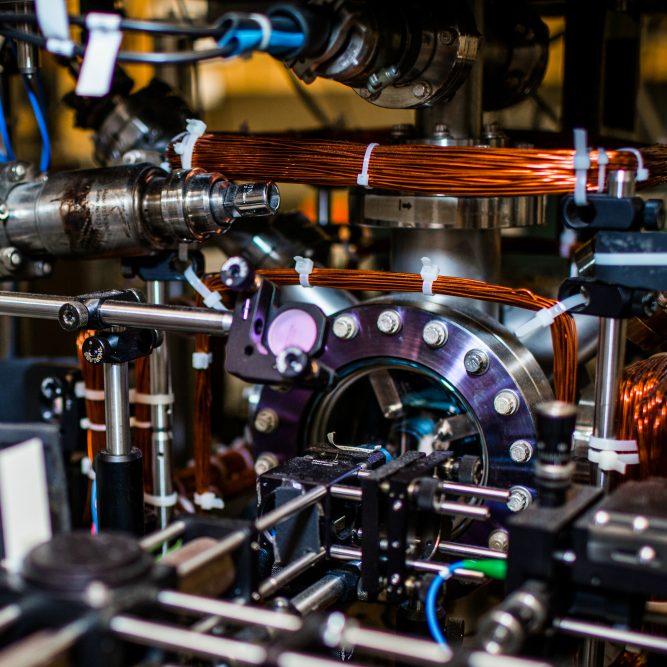Research in Atoms and Photons will focus on many-body dynamics in atomic systems that are controlled by, and interacting with, light. A technology recently developed at the CUA for creating a large number of individually controllable traps each containing a single particle will enable studies of large many-body systems with strong long-range interactions. The latter include Rydberg systems, systems of polar molecules, superradiant systems, and cavity-mediated long-range interactions. A substantial theory effort to understand and model non-equilibrium many-body dynamics in systems with long-range interactions will accompany and focus the experimental studies.
Many-body dynamics in a reconfigurable trap array
A collaboration of groups within the CUA will explore a novel scalable synthetic quantum many-body platform in the form of neutral atoms trapped in an array of reconfigurable individual dipole traps. In order to create regular, defect-free arrays of atoms on demand, we have recently developed and implemented a novel approach for rapidly creating and controlling arrays allows up to 100 dipole traps (optical tweezers). The tweezers are stochastically loaded with zero or one atoms from a magneto-optical trap. By combining a high numerical aperture lens with reprogrammable acoustooptic deflectors (AODs), one can generate, image, and reconfigure an arbitrary array of tweezers. The key innovation is that by imaging the individual atoms onto a CCD camera and reconfiguring the array based on the measurement, one can remove the entropy inherent in the stochastic loading process to deterministically create the desired configuration. Use of this approach has led to creation of defect-free arrays of over 50 atoms in less than 400 ms which is maintained by replacing lost atoms with surplus atoms from a reservoir. This approach will be employed to realize and explore a unique platform for quantum many-body dynamics. Specifically, Rydberg blockade will be used to implement state-dependent interactions and entanglement.
Strong photon-photon interactions in 1D and 2D
Previous work within the CUA has realized an optical medium in which two photons strongly interact with one another. This long-standing goal in AMO physics was achieved by combining electromagnetically induced transparency, coupling photons to collective atomic excitations, and Rydberg states, coupling the atoms to each other. This combination results in an effective strong photon-photon interaction that is mediated by the atomic Rydberg interaction. Both dissipative and dispersive single-photon nonlinearities were observed, resulting in photon blockade and two-photon bound states, respectively. The next CUA phase will also involve the exploration of universal N-body bound states in the Rydberg medium predicted from a recently developed effective field theory.
Spin squeezing on an optical atomic-clock transition
In the past, researchers within the CUA have studied how entanglement in atomic clocks can be used to overcome the standard quantum limit, either with a single atomic clock in the form of spin squeezing, or using entanglement between atomic clocks. They have also implemented spin squeezing, and demonstrated an atomic clock operating below the standard quantum limit on the hyperfine clock transition in rubidium. In the meantime, spin squeezing has been pushed from ⇠ 6 dB, corresponding to a factor of 4 reduction of clock integration time, to 18 dB, or a factor of more than 50 in integration time, by groups at Stanford and Boulder. However, all spin squeezing so far has been implemented either on magnetically sensitive transitions that are not suitable as clocks, or on hyperfine transitions with a performance many orders of magnitude below that of state-of-the-art optical transition clocks. In the future, we will implement spin squeezing and operation below the standard quantum limit on an optical clock with an intrinsic fractional stability at the 10-17 level.
Arrays of ultracold polar molecules
Unlike atoms, polar molecules have “permanent” strong, long-range, anisotropic, and fully-tunable interactions. Many critical physical parameters can be tuned using applied external fields and array parameters: interaction strength, anisotropy, range, and even the number of interacting bodies. This is a new frontier with rich and largely unexplored physics, although theory in this area is maturing, and polar molecules are of particular interest for quantum simulation and computation. Ultimately, molecules in a flexible-geometry 2D tweezer array can be made to explore interesting topological phases including quantum spin liquids. The array approach—deterministic removal of occupation entropy—is complementary to the approach where a Bose-Einstein condensate is loaded into an optical lattice. Both approaches present a powerful platform for future pursuits of exotic quantum phases of matter.
